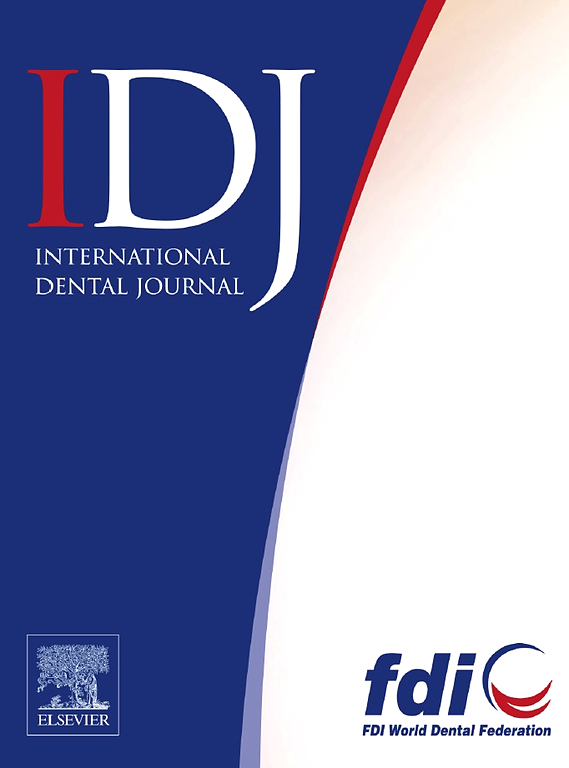Enhanced Bone Regeneration Using Demineralized Dentin Matrix: A Comparative Study in Alveolar Bone Repair
IF 3.7
3区 医学
Q1 DENTISTRY, ORAL SURGERY & MEDICINE
引用次数: 0
Abstract
Objectives
Alveolar bone resorption following tooth extraction presents significant challenges for implant-supported rehabilitations. Demineralised dentin matrix (DDM) has emerged as a promising scaffold for bone tissue regeneration. This study evaluates the bone-regenerating potential of varying degrees of dentin demineralisation.
Materials and methods
Thirty-two male white New Zealand rabbits underwent extraction of the left mandibular anterior tooth and were assigned to 4 groups: undemineralised dentin matrix (UDDM), partially demineralised dentin matrix (PDDM), completely demineralised dentin matrix (CDDM), and a control group with no treatment. At 4 and 8 weeks post extraction, cone-beam computed tomography (CBCT) was used to assess alveolar bone height and width. Histological analyses using H&E and Masson trichrome stains evaluated new bone formation, and immunohistochemistry detected osteopontin expression.
Results
CBCT imaging revealed progressive increases in alveolar bone height and width across all groups over time. Histological analysis showed new bone formation in all groups, with the PDDM group demonstrating closer integration of newly formed bone trabeculae compared with the others. IHC results showed higher osteopontin expression in the PDDM group, highlighting its superior bone-inductive potential.
Conclusion
Among the tested materials, PDDM exhibited the most effective bone induction and tissue regeneration capabilities, outperforming CDDM and UDDM in promoting alveolar bone repair. These findings position PDDM as a valuable scaffold for enhancing bone tissue regeneration in clinical applications.
Clinical relevance
The use of PDDM in tooth extraction sockets significantly promotes efficient and reliable bone regeneration, making it a valuable option for clinical applications in implant dentistry.
脱矿牙本质基质促进骨再生:牙槽骨修复的比较研究
目的拔牙后牙槽骨吸收是种植体支持康复的重要挑战。脱矿牙本质基质(DDM)是一种很有前途的骨组织再生支架。本研究评估不同程度牙本质脱矿的骨再生潜力。材料与方法雄性新西兰白兔32只,取左侧下颌前牙,分为未脱矿牙本质基质(UDDM)组、部分脱矿牙本质基质(PDDM)组、完全脱矿牙本质基质(CDDM)组和不做任何处理的对照组。拔牙后4周和8周,使用锥形束计算机断层扫描(CBCT)评估牙槽骨高度和宽度。使用H&;E和马松三色染色进行组织学分析评估新骨形成,免疫组织化学检测骨桥蛋白表达。结果scbct成像显示,随着时间的推移,所有组的牙槽骨高度和宽度均呈进行性增加。组织学分析显示,各组均有新骨形成,与其他组相比,PDDM组新形成的骨小梁融合更紧密。免疫组化结果显示PDDM组骨桥蛋白表达较高,显示其具有较强的骨诱导潜能。结论PDDM在促进牙槽骨修复方面优于CDDM和UDDM,表现出最有效的骨诱导和组织再生能力。这些发现使PDDM在临床应用中成为一种有价值的促进骨组织再生的支架。PDDM在拔牙槽内的应用显著促进了高效可靠的骨再生,使其成为种植牙科临床应用的一个有价值的选择。
本文章由计算机程序翻译,如有差异,请以英文原文为准。
求助全文
约1分钟内获得全文
求助全文
来源期刊

International dental journal
医学-牙科与口腔外科
CiteScore
4.80
自引率
6.10%
发文量
159
审稿时长
63 days
期刊介绍:
The International Dental Journal features peer-reviewed, scientific articles relevant to international oral health issues, as well as practical, informative articles aimed at clinicians.
 求助内容:
求助内容: 应助结果提醒方式:
应助结果提醒方式:


